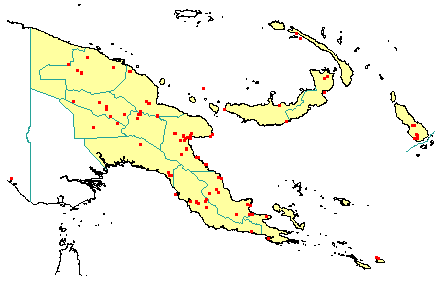
in PNGplants database
PNGTreesKey – Commersonia bartramia (L.) Merr. |
Barry Conn (NSW) & Kipiro Damas (LAE).
Guide to trees of Papua New Guinea
Copyright held by the authors, National Herbarium of New South Wales, and Papua New Guinea National Herbarium
An Interpretation of Rumphius's Herbarium Amboinense 362 (1917)
Family: Malvaceae
Dicotyledon
Timber Group: Non-timber species
Field Characters: Small sub-canopy tree (up to 25 m high); Bole cylindrical (up to 45 cm diam.); straight (bole up to c. 10 m long); buttresses buttresses absent; spines spines absent; aerial roots aerial roots absent; stilt roots stilt roots absent; Bark grey, brown (used for making rope), or red, smooth or slightly rough, pustular (sometimes (lenticels infrequent or absent), lenticels elongated laterally; Subrhytidome (under-bark) green; less than 25 mm thick, 12.0-15.0; bark blaze consisting of one layer; faintly to non-aromatic; outer blaze pale brown or pale red, markings absent, fibrous; inner blaze pale brown or pale red, markings absent, fibrous; bark exudate (sap) absent; terminal buds not enclosed by leaves.
Indumentum: Complex hairs present, star-like (stellate); stinging hairs absent; mature twig indumentum (hairs) present, hairs dense (with star-like/stellate hairs).
Leaves: Leaves spaced along branches, spiral (leaves occurring singly at a node and arranged spirally up the branchlet), simple (a leaf composed of a single blade); petiole present, not winged, attached to base of leaf blade, not swollen; leaves broadest below middle, 10.0-19.0 cm, 4.0-14.0 cm; symmetric, serrate to dentate (toothed) (shortly) or sub entire, not dissected or lobed (sometimes with a few indistinct, irregular lobes), acuminate, venation pinnate, secondary veins open, prominent, intramarginal veins absent; leaves lower surface pale green (dull (often silvery green) or dull blue-green, upper surface pale green or green (dull (to subglossy), indumentum (hairs) present (with star-like/stellate hairs), indumentum (hairs) dense; absent; domatia absent; stipules absent.
Flowers: Inflorescence axillary or leaf-opposed (flowers pleasantly aromatic), flowers on a branched axis, cones absent; flowers bisexual, stalked, flowers with many planes of symmetry, 3.0-4.0 mm long, diameter small (up to10 mm diam.) (4-5 mm diam.); perianth present, with distinct sepals and petals whorls, inner perianth white or cream-coloured; 5, free; stamens 5 (opposite the petals, with 5 staminodes (sterile) alternating with stamens: staminodes 3-lobed, each one central lobe wider than 2 lateral lobes, but shorter than petals; lateral lobes attached to filaments), present, joined (filaments joined to form a short cup), free of the perianth; ovary superior, carpels joined (when more than one), locules 5; styles partly free or at base solitary, 5.
Fruits: Infrutescence arranged on branched axis, fruit 10.0-20.0 mm long, 10.0-20.0 mm diam., brown, spiny (sub (bristly: bristle up to c. 8 mm long, covered with stellate hairs), non-fleshy, simple, dehiscent, capsule; seeds 2-(per locule)-6, barely visible (to 1 mm long) (1-1.5 mm long), not winged, broad (as wide as long), seed 1-10 mm diam. (c. 1 mm diam.).
Distribution: West Sepik, East Sepik, Madang, Morobe, Western Highlands, Eastern Highlands, Southern Highlands, Gulf, Central, Northern, Milne Bay, Papuan Islands, New Britain, New Ireland & Bougainville.
 | Botanical records in PNGplants database |
Notes: Notes The genus Commersonia was previously classified in the family Sterculiaceae.